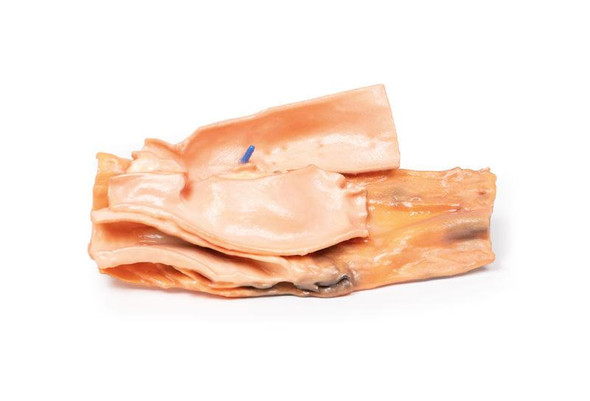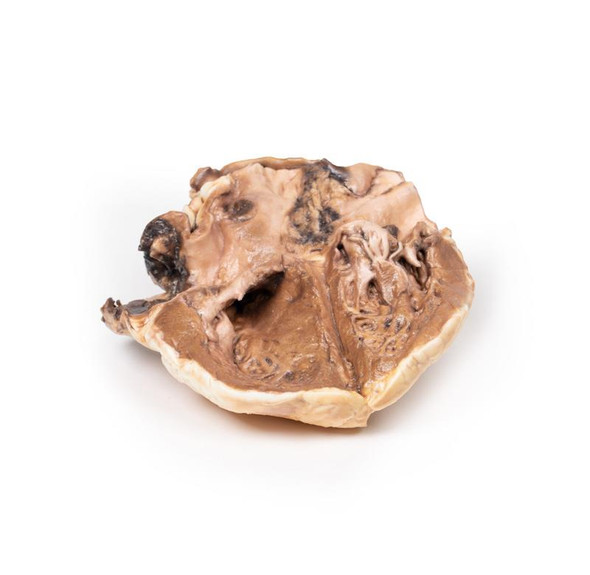Description
Clinical History
A 32-year-old female G3P0 (gravida 3, para 0 i.e., has had two pregnancies, with neither of the embryos surviving to a gestational age of 24 weeks) presents in preterm labor at 25 weeks gestation. The GP had noted an increased fundal height at 30cm one week prior, but the mother had refused prenatal testing or ultrasound, and was lost to follow up. She delivered a live born male baby. Examination of the baby noted polydactyly, imperforate anus, excessive drooling, and a loud pan-systolic murmur. A single umbilical artery was noted in the umbilical cord. The baby had difficulty feeding with increasing respiratory distress. The baby died 2 days later from aspiration pneumonia.
Pathology/Specimen Details
The specimen comprises the tongue, larynx, trachea, bronchi, both lungs and oesophagus of the fetus. The trachea and bronchi have been divided in the midline. A fistula is present just above the bifurcation at a communicating fistula can be seen connecting the distal oesophagus to the trachea (arrow). This is an example of a Type C Tracheoesophageal Fistula (oesophageal atresia with distal tracheoesophageal fistula). It is difficult to discern if the oesophagus ends as a blind pouch at the lower extent of the specimen.
Further Information
Tracheoesophageal Fistula (TEF) is a common congenital abnormality occurring in about 1 in 4000 live births. TEF usually occurs with oesophageal atresia (sometimes abbreviated to EA, reflecting the US spelling of esophagus. TEF are classified according to their anatomical configuration. Type C is the most common configuration; as described above, in which oesophageal atresia with distal tracheoesophageal fistula making up 86% of cases. TEF occurs without oesophageal atresia in only 4% of cases, Type E.
TEF and oesophageal atresia are caused by defective lateral septation of the foregut into the oesophagus and trachea. It is believed that a defect in epithelial-mesenchymal interactions causes failed branching of a lung bud branch which becomes the fistula tract. It is associated with VACTERL (vertebral defects, anal atresia, cardiac defects, TEF, renal anomalies, and limb abnormalities) or CHARGE syndrome (Coloboma, Heart defects, Atresia choanae, Growth retardation, Genital abnormalities, and Ear abnormalities).
Oesophageal atresia can be seen on prenatal ultrasound as polyhydramnios, absent/collapsed stomach, and proximal oesophageal pouch dilation. EA with TEF can be more difficult to see on ultrasound as fistula allows fluid flow into the stomach. Polyhydramnios occurs in one third of cases of EA with distal TEF. Postnatal symptoms vary on the configuration of the fistula. These include excessive drooling, respiratory distress, difficulty feeding and choking. Reflux of gastric contents can lead to aspiration pneumonia as in this case.
Diagnosis can be made by failing to pass a nasogastric tube into the stomach along with X-ray imaging. Fluoroscopy with contrast can be used for more indeterminate cases. For milder cases diagnosis may be made later with endoscopic investigation. Treatment involves surgical correction of the defects. Prognosis is usually good. However, cases with associated chromosomal, prematurity and cardiac defects are at increased risk of death.
Advantages
- Anatomically accurate and identical to real specimen
- No ethical issues - not real human body parts
- Reasonably priced
- Available within a short lead time
- Reproducible, several identical prints can be used as a classroom set
- Can be produced in different sizes to cater for the needs of the teacher
Human Cadavers
- Access to cadavers can be problematic. Many countries cannot access cadavers for cultural and religious reasons
- Cadavers cost a lot money
- High cost for establishing your own plastination suite
- Wet specimens cannot be used in uncertified labs
- Dissection of cadavers is a lot of staff time and that is a cost
- Storage of cadaver material needs special refrigeration etc. which has coast
- If you want another specimen you have to start all over again
Plastinates
- Costs
- Ethical issues
- Timeframe for plastination process
- Many countries do not allow their importation
- One of a kind
Superior 3D print results compared with conventional methods
- Vibrant color offering with 10 million colors
- UV-curable inkjet printing
- High quality 3D printing that can create products that are delicate, extremely precise and incredibly realistic
Clear Support Material
- To avoid breakage of fragile, thin, and delicate arteries, veins or vessels, a clear support material is printed on such spots. This makes the models robust and can be handled by students easily.

















